After reading Switch (affiliate link) by the Heath brothers, I am convinced that successful consulting projects must appeal to the head, the heart and the hand. It is a simple way to think about change and also makes a lot of sense.
- Head: The logic of the analysis and recommendation
- Heart: Why the client should change
- Hand: Making it easy to implement the change daily
It answers the key questions that people have. Who, What, Why, When, Where, How. The narrative goes: Yes, we need a strategy and plan (head), leadership and a call-to-action (from the heart), and some detailed steps (for the hand).
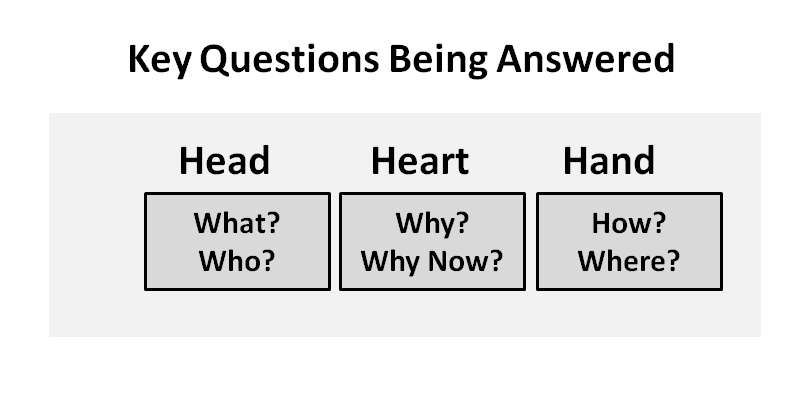 You need all three: head, heart, hand
You need all three: head, heart, hand
It’s a trifecta, but all too often executives (and consultants) only get 1 or 2 of them right. This can cause problems as described below:
#1: Head, but no Heart or Hand.
This is quite common. The consultants do a great job of solving the problem on paper, but don’t give enough consideration on how the client will motivate (heart) her people to take action, or specifically what the direct reports (hands) need to be doing. Lots of high-power thinking, but that is about it. The solution is too theoretical, complex, or radical. I have heard executives joke that consulting recommendations that were “shelf-ware” because it was so impractical that it went right on the shelf, as if it was a textbook.
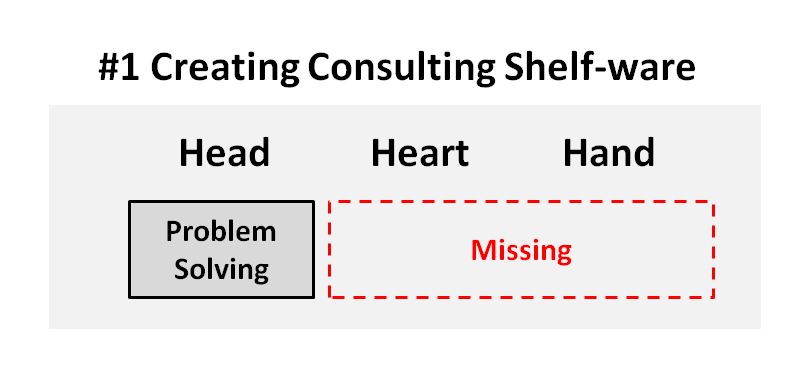 In the consultant’s defense, many clients only want the problem solving (head) and expect their internal teams to pick it up from there; they don’t want to pay consultant hourly rates for what they consider the tactical details. Knowing this, consultants often propose an optional “phase 2” of the project for the change management, risk assessments, project planning, process mapping, tool creation and other general “hand-holding”.
In the consultant’s defense, many clients only want the problem solving (head) and expect their internal teams to pick it up from there; they don’t want to pay consultant hourly rates for what they consider the tactical details. Knowing this, consultants often propose an optional “phase 2” of the project for the change management, risk assessments, project planning, process mapping, tool creation and other general “hand-holding”.
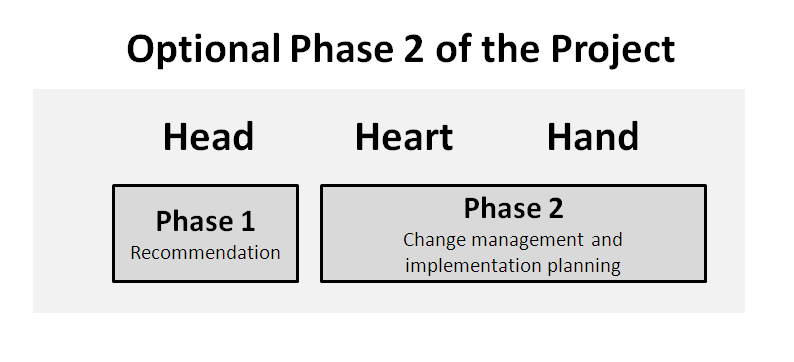 #2 Hand, but No Head, No Heart
#2 Hand, but No Head, No Heart
Sometimes a client will call you for something very tactical – perhaps writing a Standard Operating Procedure (SOP), or creating some training materials – that can be handled quickly and cheaply. Unsurprisingly, the results are also limited and muted.
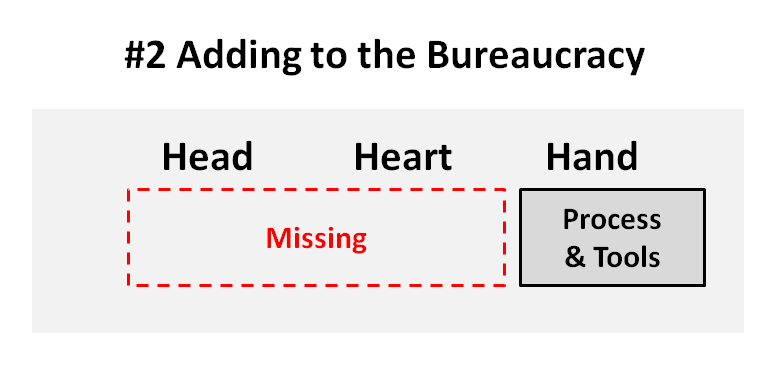 A cynic might say that that US government has this problem. Lots of rules, process, guidelines without an overarching strategy of WHAT we are doing or consensus of WHY we are doing it. An example of this might be the Frank Dodd amendment which is 848 pages long (download here, if you are brave) compared to the original, more impactful Glass-Steagall Act of 1933 (download here, only 38 pages, but just as boring) that separated commercial and investment banking. (Sidebar: Wall Street needs major reform, don’t get me wrong. Unfortunately, Frank-Dodd solved 20% of the problem, and replaced it with 20% more regulation).
A cynic might say that that US government has this problem. Lots of rules, process, guidelines without an overarching strategy of WHAT we are doing or consensus of WHY we are doing it. An example of this might be the Frank Dodd amendment which is 848 pages long (download here, if you are brave) compared to the original, more impactful Glass-Steagall Act of 1933 (download here, only 38 pages, but just as boring) that separated commercial and investment banking. (Sidebar: Wall Street needs major reform, don’t get me wrong. Unfortunately, Frank-Dodd solved 20% of the problem, and replaced it with 20% more regulation).
#3 Heart, but No Head, No Hand
Executives (CEO, COO, CEO etc) sometimes develop pet projects, especially ones that are related to leaving a legacy, that don’t always pass muster. This is probably one of the main reasons that 2/3 of mergers tend to fail (the destroy economic value). Either the deal does not make economic sense (e.g., Zynga buying Draw Something maker OMGPOP for $180 million) or there is poor implementation (e.g., see McKinsey’s report on Where Mergers go Wrong)
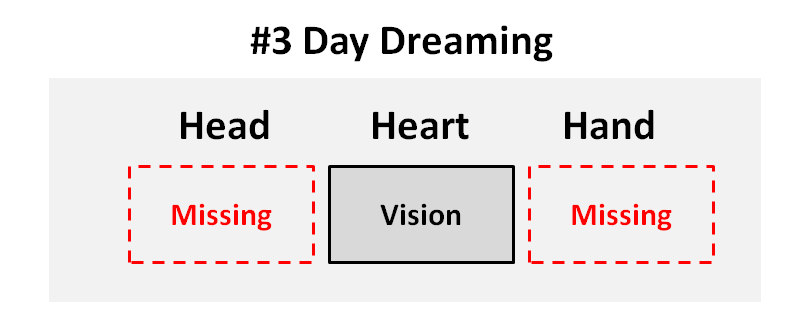 Ineffective Change
Ineffective Change
I think you get the idea. You need all three elements for change to really take root. If you only have 2 of the 3, you might reach the goal-line, but it will be slower and more painful that you anticipated. Can you imagine:
- Scenario #4: Reckless enthusiasm because there is a lot of vision, passion, activity, but not much of a plan.
- Scenario #5: Strategy without legs because there is a reasonably well thought-out plan and vision, but nothing is happening. The troops don’t know what to do.
- Scenario #6: Disjointed action because there is a strategic plan and roadmap. We all know what needs to be done, but frankly, none of us know why we are doing it – other than our bosses told us to do it.
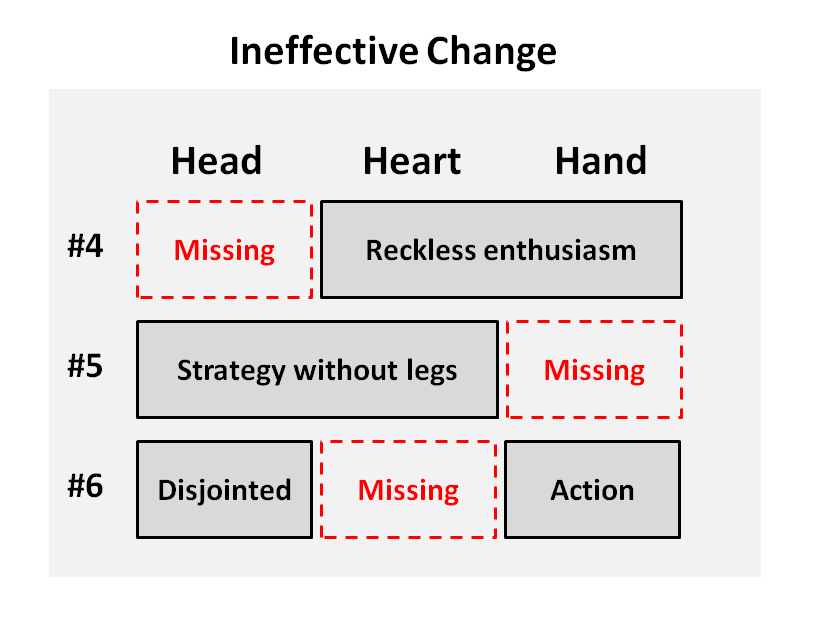 Creating effective change is an art
Creating effective change is an art
Good management consultants know how to piece together the head, heart and the hand. It can be complicated and often takes time because culture does not change over-night. We also need to remember that most people in the organization know very little about our projects. They will be the last to hear about it, and it is usually only by email or some other generic announcement. Complex problems require thinking, feeling and doing.
“For every complex problem there is an answer that is clear, simple, and wrong.” – H.L. Menken

Reminds me of “Switch, How to Change Things When Change is Hard” a book by Chip and Dan Heath. They call it the Rider, the Elephant and the Path. Thinking of Heart as Elephant kind of shifts the focus from desires to fears. Both metaphors are extremely useful. Thanks!
Absolutely. Great book, and perfectly analogous. In that book, I particularly liked the lesson they gave of the people fighting malnutrition in Vietnam. They found the positive outliers (e.g., eating small meals, and adding something to the diet) to radically improve health.
Cool write up in Fast Company
http://www.fastcompany.com/1514493/switch-dont-solve-problems-copy-success
Don’t solve problems, copy success. Amen.